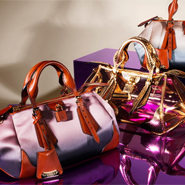- About
- Subscribe Now
- New York,
May 9, 2013

Digital innovation is a top priority for British luxury brands this year, with mobile commerce becoming an increasingly important focus, according to a new report from Walpole British Luxury and Ledbury Research.
The 2013 UK Luxury Benchmark study found that despite uncertain economic times in Europe, 83 percent of brands expect to see a rise in sales this year and the British luxury sector is on track to grow 12 percent this year as well. British luxury marketers are looking to keep their brands fresh by focusing on innovation, but a significant challenge will be joining their traditional values with the desires of the younger generations.
“The luxury landscape is changing and two of the most important challenges facing British luxury businesses in 2013 are maintaining product quality and reaching the next generation of consumers,” said Julia Carrick, chief executive at Walpole, London.
“Almost all of the surveyed brands believe that reaching the next generation will be a challenge to some degree and luxury brands must work to innovate their offering, whilst continuing to make quality, original and well-crafted products,” she said.
“This is particularly important with the demise in popularity of brand logos.”
The fourth UK Luxury Benchmark was produced by market research firm Ledbury Research in collaboration with industry trade body Walpole British Luxury, which represents brands including Burberry, Harrods and Jimmy Choo.
The survey was taken during the first quarter of 2013 by 78 senior-level marketing professionals at British luxury brands, 24 percent of whom work for apparel, footwear and accessories brands, 19 percent of whom work for travel and hospitality brands and 18 percent of whom work for jewelry and watch brands.
Growth potential
The report found that the British luxury sector could just about double in size in the next five years, bringing it from $10.2 billion in 2012 to $18.9 billion in 2017. Also, the sector is forecast to have double-digit growth each year for the next five years.
In 2013, the British luxury sector is set to grow 12 percent to $11.5 billion.
London remains the leading city for generating sales among brands in this sector in Britain. But 81 percent of these marketers have a presence outside of the city.
Manchester, England, generated the most luxury sales in 2012, according to 24 percent of respondents.
Also, Edinburgh, Scotland, was another lucrative market for luxury last year.
Respondents also reported demand for luxury in cities such as Birmingham and York, both England; and Glasgow, Scotland.
In addition, 64 percent of respondents are specifically targeting tourists with methods such as offering foreign payment methods and hiring foreign language-speaking staff.
U.S. tourists are the most important foreign group to British luxury brands, but Chinese tourists are the fastest growing group of shoppers in Britain.
Outside of their home market, the BRIC countries – Brazil, India, Russia and China – are key markets for growth for British luxury brands.
While 13 percent of British luxury brands operate in Brazil, 52 percent have plans to enter the market since the Olympics and World Cup are coming up there.
Also, 23 percent of respondents’ brands are present in India, but 50 percent are interested in entering the market for the long term.
Challenges for British luxury brands that are exploring India include the lack of infrastructure, understanding of local business culture and local regulatory environment.
Other markets that are important to British luxury brands are South Korea, Mexico, Indonesia and Vietnam.
“The report has identified that the U.K. luxury market is back in full swing and has returned to pre-financial crisis levels of growth, with 83 percent of respondents expecting to see growth this year,” Ms. Carrick said.
“We are seeing strong demand for British luxury brands both domestically – British luxury brands generate on average 51 percent of their sales from within the U.K. – and internationally,” she said.
Marketing measures
Digital innovation is a top priority for British luxury marketers.
Last year, the most widespread initiative among these brands was investment in ecommerce and social media.
Mobile commerce is growing in importance among these marketers since approximately double the respondents in this year’s study referenced mobile commerce compared to last year.
Though 98 percent of respondents believe that reaching the next generation is a challenge, some British marketers are making strides by incorporating digital channels and the interests of young consumers into the 360-degree brand experience.
For example, Burberry is establishing its global flagship store as an entertainment venue with a new ticketed concert series called “Live at 121 Regent Street” (see story).
In addition, Harrods looked to boost ecommerce through the “Opening Night” virtual shopping event that kicked off its summer campaign and offered savvy attendees flash sales, giveaways and gifts with purchase (see story).
Harrods virtual invitation
“Brands must work equally on their directly operated stores, which generate over half of sales but are declining in popularity, as their ecommerce offering - which only accounts for 19 percent of revenue - but are where respondents see the most potential,” Ms. Carrick said.
Final Take
Tricia Carr, associate reporter on Luxury Daily, New York
Share your thoughts. Click here